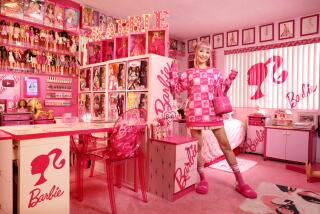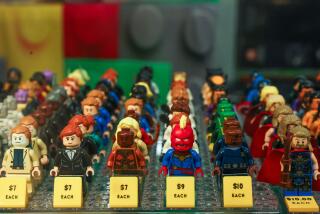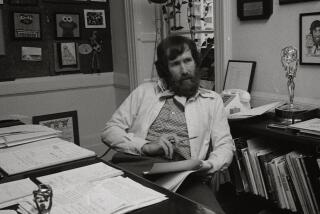One-Man Crusade to Build the Toy World of Sid and Marty Krofft
- Share via
NEW YORK — Six months ago, Hugo Stevenson was a food delivery guy in the San Fernando Valley with a good idea, but no clue how to run a business. Two months ago, life wasn’t improving. Stevenson was broke and $90,000 in debt. But last month he was standing in a showroom at Toy Fair here with the rights to turn Sid and Marty Krofft’s creatures--from Krofft-created TV shows like “H.R. Pufnstuf,” “Sigmund and the Sea Monsters” and “The Bugaloos”--into toys.
How does a start-up company with one employee compete with the toy industry’s big guns?
Persistence, the kindness of friends and a singular obsession, by Stevenson’s account.
“I’m a toy-aholic,” he concedes. “I would rather buy toys than food.”
The Kroffts, who have not granted a license for their characters in 24 years, turned down Sony Signatures, Tiger Electronics and Harvey Entertainment before giving Stevenson the license to create action figures and bean-stuffed toys in the image of the brothers’ classic TV characters. There were two caveats--he had to make it to this year’s Toy Fair to keep the license, and he had to cede a percentage of the royalties to the Kroffts.
“They simply wanted to give a friend a chance,” says Stevenson, who dubbed his new Woodland Hills-based company Living Toys.
For six months, the 29-year-old entrepreneur worked day and night. The effort paid off.
“The first day [of Toy Fair],” Stevenson says, “we did a $500,000 sale to one buyer.” Smaller neighborhood stores wrote Living Toys checks for $1,000, $5,000 and $10,000, Stevenson says. But in the weeks since Toy Fair, Stevenson has closed deals with Musicland, the Wherehouse and Diamond Comic Distributors. Interactive CD-ROM companies and other major toy companies and distributors are in negotiations with Living Toys. Thus far, in the month that Living Toys has been making deals the tiny company has reached $2.5 million in sales.
Because of Stevenson’s success, the heirs to Rand McNally have invested in the company and the Kroffts decided to buy a 25% stake too.
“No one is going to hand it to you,” Stevenson says. “Unless you take the risk, success will always elude you.”
The road to Toy Fair didn’t begin with the Kroffts. Stevenson, who moved to Los Angeles in 1993 after college, put himself in the toy business to help promote “Hugo’s Hideaway,” a children’s show he developed in between his day job as a production assistant and his night job delivering food for neighborhood restaurants.
Set in a seaside cave, “Hugo’s Hideaway” is designed to teach children about oceans and sea creatures and caught the attention of Nicolas Cage and Jeff Levine at Saturn Films. Saturn provided a link to Creative Artists Agency, where agents suggested that Stevenson find innovative ways to promote his show. Stevenson settled on toys, in the hope that if the plush bean bag toys modeled after his show’s characters caught on, maybe someone would buy the show as well. A friend invested $52,000 in Living Toys, and promised more if Stevenson needed it.
“I had no idea what I was getting into,” Stevenson now says. “I knew it could be done. But how do you do it?”
Surfing the Internet he found companies in Asia that would produce prototypes. He also located artists, packagers, advertisers and an insurance company. He incorporated his company and obtained trademarks for his products.
“I lived day by day, hand to mouth for the last year and a half while putting this project together,” Stevenson says. “Every spare dime I put into this . . . to make it happen.”
Finally, with a couple of prototypes from “Hugo’s Hideaway” in hand, Stevenson approached Sid and Marty Krofft. Stevenson had known the Kroffts for a couple of years having met them through a mutual friend while working as a story editor for Parkwood Pictures.
“This guy is the terminator,” Marty Krofft says. “He never backs off.”
In their view, Stevenson knew a lot about the Krofft shows and the toy industry. “He just had stuff going,” Marty Krofft says. “By the time he was announcing something, he never asked you. He doesn’t stop for anybody.”
The Kroffts also wanted to keep control of their characters, and some of the larger companies that had approached them would not have allowed this. “We are probably the last of the independents,” Marty Krofft says. “I go for the underdog.”
A week before Christmas, Stevenson was a clear underdog. His sole investor pulled out and he still needed $200,000 to prepare his wares for Toy Fair. His designers and manufacturers agreed to keep working on the promise he would find the money--soon. “Everyone was gracious enough to work out of their own pockets and try to make this happen,” Stevenson says.
A few weeks before Toy Fair, Stevenson still did not have enough money to make it to Manhattan and despondently continued with his food delivery job. But his luck turned once again when his boss decided, along with two friends, to invest.
A couple of days before Toy Fair, some of the prototypes arrived from Asia and Stevenson took a plane from Woodland Hills to Manhattan. The next day, he received his product catalog by Federal Express. After the fair began, the rest of his action figures, along with the packaging, trickled in. “We couldn’t be cutting things closer if we tried,” Stevenson said at the time.
Jim Dultz, the Emmy Award-winning designer of “Muppets Tonight,” designed Stevenson’s Toy Fair booth, based on “H.R. Pufnstuf.” A friend helped advertise by wearing a Pufnstuf costume and walking through Toy Fair. His mother distributed postcards and buttons.
Because of Living Toys’ sudden success, Stevenson has postponed work on “Hugo’s Hideaway.” Production, however, will begin this fall. Stevenson hopes to release the show in the fall of 2000.
More to Read
Inside the business of entertainment
The Wide Shot brings you news, analysis and insights on everything from streaming wars to production — and what it all means for the future.
You may occasionally receive promotional content from the Los Angeles Times.










